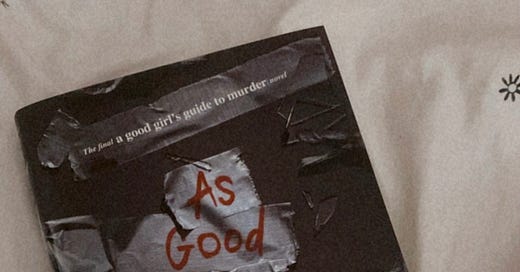disclaimer: this review was written in 2022 and reviewed and added on for this blog post specifically.
I have finally finished the last book from "A Good Girl's Guide to Murder," called "As Good As Dead."
In this book, the main character is not trying to solve a five-year-old mystery to clean someone's name or a recent-missing-persons case. She is trying to save herself, her life.
It is interesting because it is (again) connected to people and happenings from the first and second books. That is my favorite part of the whole series: how everything ties together to the beginning, mainly because the case she is currently working on is the beginning of it all.
It is the beginning of the murders that are investigated in the first book and why her friend's brother went missing in the second.
This time, she is being stalked by this man who uses the same techniques as a specific serial killer from years ago. It is not possible, however, to be the same person since the police have already arrested him, right? Wrong.
The book is divided into two parts: the before she finds who he is and what happens next.
This book series is so smart, mainly because the author alters the vision and thoughts of who can be or what will happen by adding leads that may contradict the previous ones.
To write a murder mystery, you have to do it right. It cannot be written as a romance, which most likely everyone could write. Mysteries need to be eye-catching, give the reader nail-biting terror, and have great leads and suspects.
I thought the portrayal of the feelings of the main character throughout the book was interesting.
At the end of the second book, she goes through a very traumatic experience, which keeps being repeated over and over in her head.
This repetition seemed to be PTSD, in my point of view (it is not confirmed by telling; it is shown throughout the book), since those memories would come with health and psychological consequences, as well as an addiction to sleeping pills.
The anxiety and panic attacks are not per se called by their names in the book, but we read about them, and we (readers) can feel the desperation and hopelessness of the character.
I could even say that it would not be ideal for someone in any of these conditions to read the book because, contrary to what I thought of the first one, the level of the graphic descriptions increased throughout the series.
It is still not very graphic in terms of the details of death that are not important to the investigation (as it is a young adult genre), but the story and murders become more vivid for the reader.
To spare the reader from murder, mystery, and scary moments, many characters use too many puns and jokes to add comic relief to the book. Only one thing was wrong: the characters openly tell us what they are doing. We get it. There is no need to confirm it to us as much as there is no need to confirm that a mystery has to be solved.
The second part of the book is about how the main character uncovers a murder that she committed.
After reading the book, some may say she did a good thing by murdering a serial killer, but some may say she had the opportunity just to run away and go to the police.
This is one of the many psychological debates from the main character besides the trauma of having someone being shot six times right next to you.
What the main character does by uncovering her murder and framing someone else is the same thing she judged her friend's father did in the first book. The question, however, is if it's so bad to frame someone as evil as they might be.
This is the criteria the main character uses to frame yet another character from the book. Since the first one, he has been an important factor in many murders and many not-so-random coincidences that made him a criminal.
Pip feels it has been hard to hold him accountable for his actions, so this would be an escape for the main character, and he would be put in jail.
I felt that this book is all about the in-between the gray areas of right and wrong and the dilemmas of good and bad, which are topics the main character keeps saying she has to choose good and right, but her life became a gray mix of all of the options above.
I wonder…do you stand on black and white, or do you believe in gray?
My favorite parts/quotes from this book were on pages 50, 66, 194, and 455:
“They were still here, those chalk figures. Five little stick people without their heads. Except, no, that couldn’t be right. It had rained yesterday, hard, and they definitely hadn’t been here when Pip left for her run. They hadn’t, she swore. And there was something else too.
She bent to get a closer look. They had moved.”
“DEAD GIRL WALKING”
“Who will look for you when you’re the one who disappears?
p.s. I learned this trick from you, season 1 episode 5.
Ready for my next trick?”
“Hey Sarge, remember me?”
455 Pages
Delacorte Press
Read you soon,
Bea
Photo by: Bea Barros.




